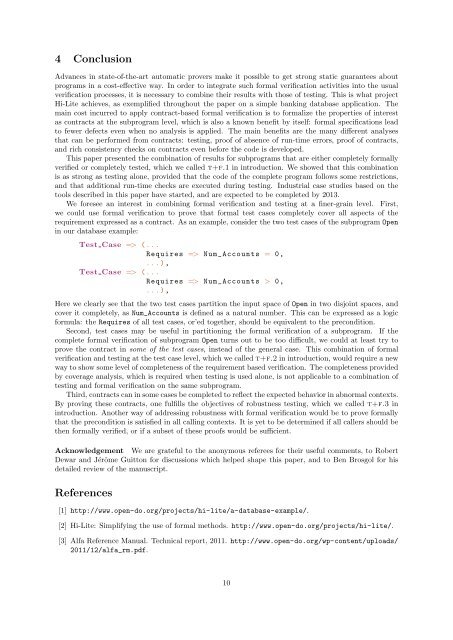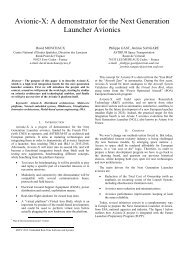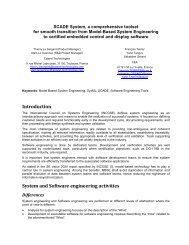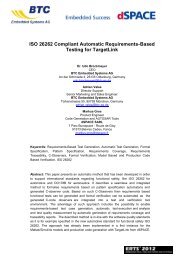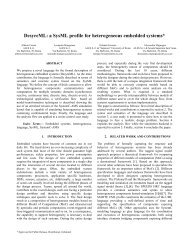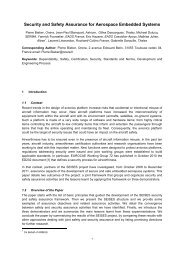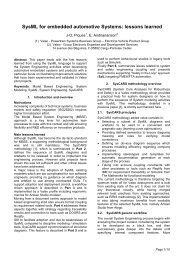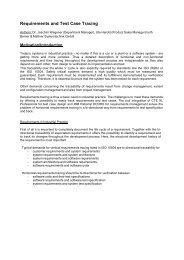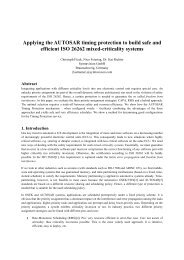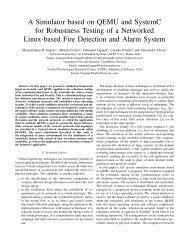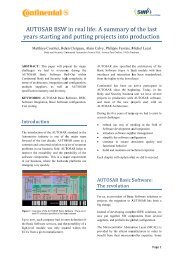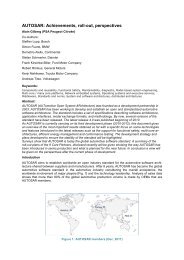Integrating Formal Program Verification with Testing
Integrating Formal Program Verification with Testing
Integrating Formal Program Verification with Testing
- No tags were found...
You also want an ePaper? Increase the reach of your titles
YUMPU automatically turns print PDFs into web optimized ePapers that Google loves.
4 ConclusionAdvances in state-of-the-art automatic provers make it possible to get strong static guarantees aboutprograms in a cost-effective way. In order to integrate such formal verification activities into the usualverification processes, it is necessary to combine their results <strong>with</strong> those of testing. This is what projectHi-Lite achieves, as exemplified throughout the paper on a simple banking database application. Themain cost incurred to apply contract-based formal verification is to formalize the properties of interestas contracts at the subprogram level, which is also a known benefit by itself: formal specifications leadto fewer defects even when no analysis is applied. The main benefits are the many different analysesthat can be performed from contracts: testing, proof of absence of run-time errors, proof of contracts,and rich consistency checks on contracts even before the code is developed.This paper presented the combination of results for subprograms that are either completely formallyverified or completely tested, which we called t+f.1 in introduction. We showed that this combinationis as strong as testing alone, provided that the code of the complete program follows some restrictions,and that additional run-time checks are executed during testing. Industrial case studies based on thetools described in this paper have started, and are expected to be completed by 2013.We foresee an interest in combining formal verification and testing at a finer-grain level. First,we could use formal verification to prove that formal test cases completely cover all aspects of therequirement expressed as a contract. As an example, consider the two test cases of the subprogram Openin our database example:Test Case => ( . . .Requires => Num_Accounts = 0,. . . ),Test Case => ( . . .Requires => Num_Accounts > 0,. . . ),Here we clearly see that the two test cases partition the input space of Open in two disjoint spaces, andcover it completely, as Num_Accounts is defined as a natural number. This can be expressed as a logicformula: the Requires of all test cases, or’ed together, should be equivalent to the precondition.Second, test cases may be useful in partitioning the formal verification of a subprogram. If thecomplete formal verification of subprogram Open turns out to be too difficult, we could at least try toprove the contract in some of the test cases, instead of the general case. This combination of formalverification and testing at the test case level, which we called t+f.2 in introduction, would require a newway to show some level of completeness of the requirement based verification. The completeness providedby coverage analysis, which is required when testing is used alone, is not applicable to a combination oftesting and formal verification on the same subprogram.Third, contracts can in some cases be completed to reflect the expected behavior in abnormal contexts.By proving these contracts, one fulfills the objectives of robustness testing, which we called t+f.3 inintroduction. Another way of addressing robustness <strong>with</strong> formal verification would be to prove formallythat the precondition is satisfied in all calling contexts. It is yet to be determined if all callers should bethen formally verified, or if a subset of these proofs would be sufficient.Acknowledgement We are grateful to the anonymous referees for their useful comments, to RobertDewar and Jérôme Guitton for discussions which helped shape this paper, and to Ben Brosgol for hisdetailed review of the manuscript.References[1] http://www.open-do.org/projects/hi-lite/a-database-example/.[2] Hi-Lite: Simplifying the use of formal methods. http://www.open-do.org/projects/hi-lite/.[3] Alfa Reference Manual. Technical report, 2011. http://www.open-do.org/wp-content/uploads/2011/12/alfa_rm.pdf.10


